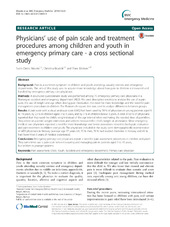| dc.contributor.author | Moutte, Svein-Denis | en_US |
| dc.contributor.author | Brudvik, Christina | en_US |
| dc.contributor.author | Morken, Tone | en_US |
| dc.date.accessioned | 2016-03-09T12:52:38Z | |
| dc.date.available | 2016-03-09T12:52:38Z | |
| dc.date.issued | 2015-11-06 | |
| dc.Published | BMC Emergency Medicine 2015, 15:33 | eng |
| dc.identifier.issn | 1471-227X | |
| dc.identifier.uri | https://hdl.handle.net/1956/11490 | |
| dc.description.abstract | Background: Pain is a common symptom in children and youth attending casualty centres and emergency departments. The aim of this study was to acquire more knowledge about how pain in children is measured and handled by emergency primary care physicians. Methods: A structured questionnaire study was performed among 75 emergency primary care physicians in a Norwegian accident and emergency department (AED). We used descriptive statistics to analyse the use of a pain scale, the use of weight and age when dosing pain medication, the need for more knowledge and the need for pain management procedures in children. The Pearson chi-square test was used to analyse differences between groups. Results: A pain scale with a visual analogue scale (VAS) had been used by 59 % of physicians in young patients aged 9 to 19 years, by 23 % in children aged 3 to 8 years, and by 3 % in children below 3 years. A total of 63 % of physicians reported that they used the child’s weight instead of the age interval when estimating the needed dose of painkillers. They relied on parents’ weight estimation and seldom measured the child’s weight at attendance. Most emergency medical care physicians reported a need for more knowledge and better procedures related to both pain evaluation and pain treatment in children and youth. The physicians included in the study were demographically representative of AED physicians in Norway (average age 37 years old, 55 % men, 76 % had studied medicine in Norway and 49 % had fewer than 5 years of medical experience). Conclusions: Emergency primary care physicians report a need for pain assessment procedures in children and youth. They sometimes use a pain scale when measuring and managing pain in patients aged 9 to 19 years, but seldom in younger patients. | en_US |
| dc.language.iso | eng | eng |
| dc.publisher | BioMed Central | eng |
| dc.rights | Attribution CC BY | eng |
| dc.rights.uri | http://creativecommons.org/licenses/by/4.0 | eng |
| dc.subject | Pain assessment | eng |
| dc.subject | Child | eng |
| dc.subject | Youth | eng |
| dc.subject | Accident and emergency department | eng |
| dc.subject | Primary care physician | eng |
| dc.title | Physicians’ use of pain scale and treatment procedures among children and youth in emergency primary care - a cross sectional study | en_US |
| dc.type | Peer reviewed | |
| dc.type | Journal article | |
| dc.date.updated | 2015-11-10T13:08:52Z | |
| dc.description.version | publishedVersion | en_US |
| dc.rights.holder | Copyright 2015 The Authors | |
| dc.identifier.doi | https://doi.org/10.1186/s12873-015-0059-9 | |
| dc.identifier.cristin | 1287370 | |

